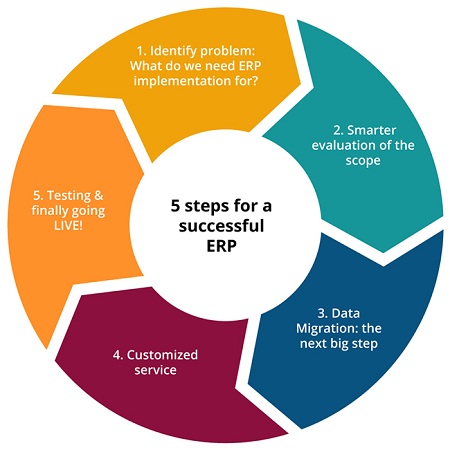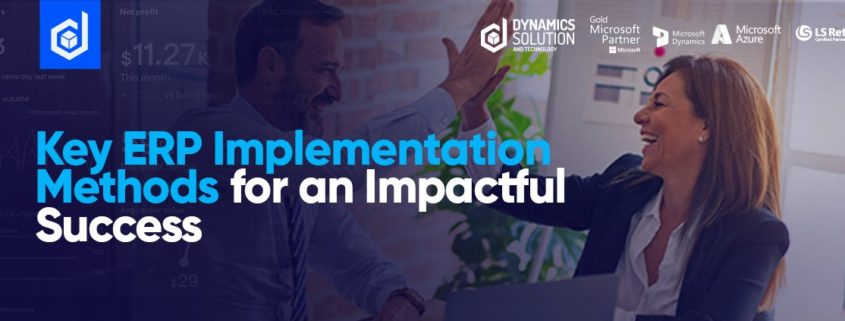Every day, businesses encounter new obstacles. Priorities fluctuate, markets shift drastically, opportunities develop, and the pace of these events does not slow. As your competitor’s business models develop swiftly and consumer expectations shift, your future will be determined by how effectively you can enable your staff to adapt, innovate, and make a positive difference every day. You must be prepared for disruption, embrace ongoing change, and, most importantly, be quick on your feet.
To make your business more sustainable, prosperous, and useful to humankind at a massive scale, making people’s lives easier, you’ll need a system that allows you to take all the stages described above.
ERP Implementation is a business solution software handling day-to-day company operations such as accounting, and procurement, project management, risk management, compliance, and supply chain functions.
Following a comprehensive procedure and selecting a suitable provider such as Dynamics 365 ERP is just as important as choosing the ideal ERP implementation partner when it comes to Enterprise Resource Planning (ERP) deployment.
You have a significantly better chance of success if you use a streamlined and proven method to implement.

If we go back in time, this technique was initially based on Microsoft’s Sure Step approach with distinguished “design” and “development” processes.
It is a recommended methodology for adopting Microsoft Dynamics AX, allowing for more real-time feedback from clients and solution partners, less rework, and a better final fit with customer objectives.
However, with the surfacing of Microsoft Dynamics 365 ERP, things have changed for the better and in such a manner that businesses are becoming more effective swiftly. The global business arena is transforming with the Dynamics 365 ERP system, and productivity is increasing exponentially.
At a holistic and efficient scale, Dynamics 365 ERP includes product-specific and general project-based templates, procedures, flow charts, and tools to assist partners with seamless adoption.
This article is intended to showcase the ERP deployment process, specifically the Dynamics 365 solution, and describe the procedural steps to steer you in the proper direction.
-
Identification and Planning
Knowing your own company, industry, and customers can help you choose the best ERP solution(s). You will undertake early discovery sessions with your solution partner at this stage to establish your fundamental requirements for the new ERP.
This stage provides solutions to high-level pain points such as;
- Primary prerequisites for the new ERP
- Complex operations (such as manual data input) will be eliminated
- Integration of other business apps with the ERP
Because the diagnostic phase is typically completed prior to the approval of a large letter of engagement, some authorities exclude it from reporting the implementation process.
It is, nonetheless, required for risk minimization and a thorough diagnostic method will help you prevent unpleasant surprises during the next stage, Evaluation.
-
Evaluation
In this stage, you and your partner will go through your business procedures and requirements. Having a clear idea about all the relevant facts regarding your own business, industry, and clients can help you with all the crucial decisions at large.
Your solution provider should collaborate intrinsically with you to ensure that all the critical business processes need to be chronically registered.
At the end of this stage, you should have a statement of work for the implementation project, along with the documentation of business needs and solutions provided by your partner.
This detail is commonly referred to as
- Documentation of Business Requirements (BRD)
- Documentation of Functional Requirements (FRD)
- Analysis of Fit-Gaps
- Proposal for a Solution Design
This documentation serves as the foundation for the following stage, solution modeling.
-
Solution Design
The solution modeling stage is by far the most extensive, including multiple sub-steps:
- Technical configuration
- Documentation and design
- Development and Alignment
- Planning for Data Migration
Structure and setup entail configuring the intricacies of the ERP’s interface and functionality. An ERP system, such as Dynamics 365 Business Central or Finance & Operations, may be customized diversely.
Customization involves development. In a nutshell, customization is more complex than configuration and often results in additional maintenance expenditures.
-
Implementation
During the deployment phase, your business and opted ERP implementation partner prepare to go live with the D365 ERP.
Several technical phases are involved in this process, including:
- Production environment creation
- Holistic Testing of the system
- Validation and data migration
Microsoft Dynamics 365 functions in both directions. The Microsoft Ecosystem i.e. Dynamics 365, M365, and, more importantly, Microsoft Azure cloud services are available for both on-premise and cloud implementation.
This process also entails training your whole workforce. For a flawless and impactful implementation, the ERP implementation partner must be of high caliber, with relevant skills and a global footprint, knowing varied markets and industries, and top people with hands-on deployment experience.
In addition, Dynamics 365 ERP Market Share
According to TrustRadius 2021, the top leader in today’s ERP industry is Microsoft Dynamics 365, based on buyer interest.

-
Training and Testing
In order to have smooth results and great impact, User acceptability testing and initial training are very pivotal. Hence, The training approach must be rigorous and smart in strategy. Allow your partner to concentrate on thoroughly instructing your team’s sharp members.
Those team members will train the remainder of related personnel throughout the deployment phase. This process deepens and strengthens your company’s grasp of its new ERP.
User Acceptance Testing (UAT) is a significant element in any ERP deployment but is often overlooked to achieve the “goal” of going live. It is essential that your existing team members must conduct testing (who are already well-trained).
Dynamics Solution and Technology, as a Microsoft Gold Partner, provides tried and reliable services in a highly scalable and personalized manner. In numerous projects, testing and training can be employed as part of the deployment process.
-
Go-Live Operation
The operation’s purpose is to move you from the implementation project to continuing assistance after a successful go-live. You may also have ad hoc queries that demand your partner’s input.
- The new ERP is handed over to the customer at the end of this phase, with continued assistance from your partner.
ERP Post-Implementation Project Governance
At the same time as all the aforementioned steps in the implementation are taking place, it is critical that you and your partner have adequate project governance for the process.
Depending on the complexity of your project, one or two levels of governance will be required.
The project management group. This group is in charge of the project’s day-to-day operations. They must:
- Create a project schedule and keep track of its progress.
- Handle requests for transformation
- Identify, manage, and communicate risks, as well as their potential impact on timelines, budgets, and deliverables.
- When required, escalate concerns to project sponsors in advanced projects.
Your implementation partner should oversee the project, and in big implementations, the client should also have a project manager.
When you go live, you should also prepare for continuing support and upgrades. ERP implementation software, like any other company software, will require ongoing support and upgrades. The company’s needs might vary over time, and the ERP implementation software should be changed to meet these new demands. In addition, new ERP software users will need to be trained accordingly.
Endeavor Dynamics Solution and Technology and Find Out Why!
Our responsible business performance with quality ensured and values upheld is one of the most compelling factors to choose Dynamics Solution and Technology as your digital transformation partner.
To embrace a new digital approach with Us, DST is the one-stop solution for all your business’s digital transformation needs, particularly upgrading from Microsoft AX to Dynamics 365 as we keep your business vision in mind by paying attention to your market requirements from the beginning of the implementation process.
At Dynamics Solution and Technology, our work doesn’t stop after installation. We offer experience, information, and support even after your solution is live, making us the ideal all-rounder Microsoft Gold Partner to handle Your Dynamics 365 ERP implementation or up-gradation.
To discuss your industry and specifically your business and the challenges it is facing.







